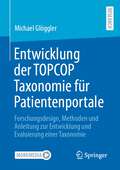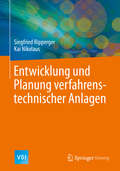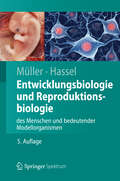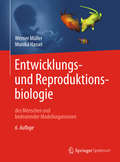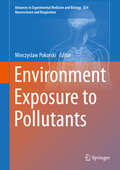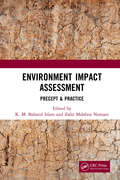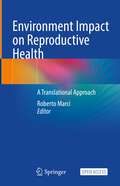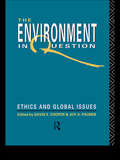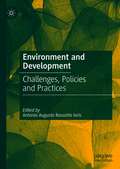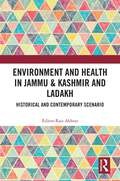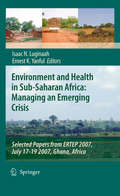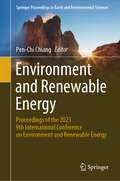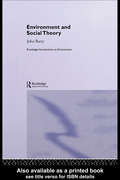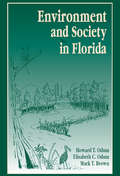- Table View
- List View
Entwicklung der TOPCOP Taxonomie für Patientenportale: Forschungsdesign, Methoden und Anleitung zur Entwicklung und Evaluierung einer Taxonomie
by Michael GlögglerTaxonomien sind Modelle, um unübersichtliche Domänen zu analysieren, Komplexität zu reduzieren sowie Unterschiede und Ähnlichkeiten von Objekten zu erkennen. Ferner helfen sie, Wissen zu ordnen und so Wissen zu vergrößern. Da täglich neues Wissen entsteht, ist eine nutzungsorientierte Entwicklung von Taxonomien für die Wissenschaft und die Praxis von fundamentaler Bedeutung. Taxonomien sind unerlässlich für die Erforschung, Beschreibung und Strukturierung von Domänen. Trotz ihrer besonderen Bedeutung gibt es für viele Wissenschaften nur wenige Handlungsanleitungen zur Entwicklung von Taxonomien.In diesem Buch werden die Forschungsergebnisse der Dissertation mit dem Titel „Entwicklung einer Taxonomie für Patientenportale für Health Information Manager“ präsentiert. Aufgrund der detaillierten Darstellung der Entwicklungsschritte und der eingesetzten Methoden kann diese Dissertationsforschung als Anleitung zur Entwicklung von Taxonomien dienen. Dabei ist die Evaluierung für die Nützlichkeit einer Taxonomie maßgeblich. Mit dem „TED Taxonomy-Evaluation-Delphi Approach“ entwickelte der Autor eine neue Methode zur Evaluierung von Taxonomien, welche hier ausführlich beschrieben wird.
Entwicklung und Planung verfahrenstechnischer Anlagen (VDI-Buch)
by Siegfried Ripperger Kai NikolausDieses Fachbuch vermittelt wesentliche Grundlagen für die Entwicklung und Planung verfahrenstechnischer Anlagen, bei der technische, betriebliche, wirtschaftliche und rechtliche Forderungen beachtet werden müssen. Nach einer Einführung in die Anlagentechnik und das Projektmanagement werden wirtschaftliche Aspekte betrachtet, da die notwendigen finanziellen Mittel für eine Anlage in der Regel durch den zu erwartenden wirtschaftlichen Nutzeffekt gerechtfertigt werden. Verfahrenstechnische Anlagen sind oft einzigartig. Um dennoch eine zügige Projektabwicklung zu gewährleisten und um Kosten zu senken kommt der Modularisierung eine immer größere Bedeutung zu. Daher ist diesem Trend ein eigenes Kapitel gewidmet. Nach einer kurzen Einführung in das technische Recht werden zu beachtende rechtliche Aspekte behandelt. Weitere Kapitel beschreiben die Rolle der Normung, die große Palette der verwendeten Werkstoffe sowie bekannte Regeln zur Dimensionierung und Gestaltung von Bauelementen der Apparate.
Entwicklung und Validierung einer Prüfsystematik zur Charakterisierung von additiv gefertigten Thermoplast-Leichtbaustrukturen (Werkstofftechnische Berichte │ Reports of Materials Science and Engineering)
by Patrick StriemannDieses Buch befasst sich mit der Charakterisierung von additiv gefertigten Thermoplast-Leichtbaustrukturen. Die prozessbedingten Eigenheiten der additiven Fertigung beeinflussen die Prüfstrategien und die Charakterisierungsergebnisse. Daher werden einzelne Prüfstrategien zur Beurteilung der Qualität und der Leistungsfähigkeit auf das Verarbeitungsverfahren angepasst. Die qualitative Beurteilung erfolgte oberflächen- und volumenbasiert. Durch die Kombination beider Methoden konnten Ansammlungen von Porenvolumen den Fertigungseffekten zugeordnet werden. Die Bewertung des Verformungsverhaltens erfolgte in einem breiten Dehnratenbereich (statisch, quasistatisch und dynamisch), das Ermüdungsverhalten unter zyklischer Belastung wurde bis 108 Lastwechsel charakterisiert. Für die Untersuchungen im VHCF-Bereich wurde ein Hochfrequenz-Prüfsystem verwendet und die Temperaturentwicklung überwacht. Die adaptierten und neuentwickelten Prüfstrategien lassen sich in einer Prüfsystematik zusammenfassen, die die fertigungsbedingten Einflüsse berücksichtigen und einen sicheren Betrieb von langzeitbeanspruchten Thermoplast-Leichtbaustrukturen gewährleisten.
Entwicklung von Open-Source-Medizinprodukten: Ein verlässlicher Ansatz für eine sichere, nachhaltige und zugängliche Gesundheitsversorgung
by Andrés Díaz Lantada Arti Ahluwalia Carmelo De MariaDieses Buch befasst sich mit den Herausforderungen und Möglichkeiten von Open-Source- und kollaborativen Designansätzen und -strategien im biomedizinischen Bereich. Es bietet eine umfassende Reihe von bewährten Verfahren und Methoden, damit diese sicheren, innovativen und zertifizierbaren biomedizinischen Geräte die Patienten erreichen und erfolgreiche Lösungen für Probleme im Gesundheitswesen bieten. Die Kapitel sind so gegliedert, dass sie den gesamten Lebenszyklus von Open-Source-Medizintechnologien verfolgen. Die bereitgestellten Informationen sind äußerst praxisorientiert, da sie sich auf reale Studienfälle stützen, bei denen sich die Zusammenarbeit zwischen medizinischen Fachkräften, Ingenieuren und Technikern, Patienten und Patientenverbänden, politischen Entscheidungsträgern, Regulierungsbehörden und Bürgern als vorteilhaft erwiesen hat. Das Buch wird auch durch eine Online-Infrastruktur, UBORA, unterstützt, über die Open-Source-Medizinprodukte gemeinsam entwickelt und geteilt werden können, um die Medizintechnik zu demokratisieren und eine zugängliche biomedizintechnische Ausbildung zu fördern.
Entwicklungsbiologie und Reproduktionsbiologie des Menschen und bedeutender Modellorganismen
by Werner A. Müller Monika HasselDie faszinierende Entwicklung von Ei und Spermium zum komplexen Organismus ist das Thema des Lehrbuchs. Die Autoren liefern einen Überblick über die Entwicklung wichtiger Modellorganismen und die Embryonalentwicklung des Menschen. Dabei berücksichtigen sie aktuelle Forschungsfragen wie u. a. Klonen, transgene Tiere und Gentherapie. In der 5. Auflage sind alle Abbildungen 4-farbig, die Themen "Entwicklung des Menschen" und "Evolution von Entwicklungsprozessen" werden ausführlicher dargestellt. Mit umfangreichem Glossar und Literaturverzeichnis.
Entwicklungsbiologie und Reproduktionsbiologie des Menschen und bedeutender Modellorganismen (Springer-lehrbuch)
by Werner A. Müller Monika HasselDie faszinierende Entwicklung von Ei und Spermium zum komplexen Organismus ist das Thema des Lehrbuchs. Die Autoren liefern einen Überblick über die Entwicklung wichtiger Modellorganismen und die Embryonalentwicklung des Menschen. Dabei berücksichtigen sie aktuelle Forschungsfragen wie u. a. Klonen, transgene Tiere und Gentherapie. In der 5. Auflage sind alle Abbildungen 4-farbig, die Themen „Entwicklung des Menschen“ und „Evolution von Entwicklungsprozessen“ werden ausführlicher dargestellt. Mit umfangreichem Glossar und Literaturverzeichnis.
Enumerations: Data and Literary Study
by Andrew PiperFor well over a century, academic disciplines have studied human behavior using quantitative information. Until recently, however, the humanities have remained largely immune to the use of data—or vigorously resisted it. Thanks to new developments in computer science and natural language processing, literary scholars have embraced the quantitative study of literary works and have helped make Digital Humanities a rapidly growing field. But these developments raise a fundamental, and as yet unanswered question: what is the meaning of literary quantity? In Enumerations, Andrew Piper answers that question across a variety of domains fundamental to the study of literature. He focuses on the elementary particles of literature, from the role of punctuation in poetry, the matter of plot in novels, the study of topoi, and the behavior of characters, to the nature of fictional language and the shape of a poet’s career. How does quantity affect our understanding of these categories? What happens when we look at 3,388,230 punctuation marks, 1.4 billion words, or 650,000 fictional characters? Does this change how we think about poetry, the novel, fictionality, character, the commonplace, or the writer’s career? In the course of answering such questions, Piper introduces readers to the analytical building blocks of computational text analysis and brings them to bear on fundamental concerns of literary scholarship. This book will be essential reading for anyone interested in Digital Humanities and the future of literary study.
Environment - Competitive exam
by Shankar IasThe best book on environment, recommended by civil service exam experts. The book includes the previous year question and point by point description and analysis.
Environment Exposure to Pollutants
by Mieczyslaw PokorskiThe impairment of lung function caused by environmental exposure to pollutants and toxicants is a rising health problem, particularly in highly industrialized parts of the world. The problem is urgently calling for the development of new methodologies to assess both the level of elemental exposure and the effects for quality of health and longevity. This volume provides state-of-the-art information about the recent advances in occupational and non-occupational pollutant-related disorders of the respiratory tract, and the assessment of a threat they pose for the health-span. Heavy traffic-related air pollution, unnoticeable but salient health detriment, is dealt with at length.
Environment Impact Assessment: Precept & Practice
by K. M. Baharul Islam; Zafar Mahfooz NomaniEnvironment Impact Assessment: Precept & Practice deals with theoretical, practical, managerial and legal issues in multidisciplinary holism to suit Indian environmental planning and governance. Environment Impact Assessment is not only considered a tool for sustainable development but a promissory augury of creation of equitable regime of for ecosystem governance. The book is laced with polemical issues in dexterous detail to cater erudite demand of environmental planners besides fulfilling the void of curriculum and pedagogic requirements of technical universities, environmental management and legal studies. The book offers diversity of thoughts across discipline on Environment Impact Assessment discourse in rounded perspective having immense potential for textual and reference utilities. The treatment of subject is not only discursive but paradigmatic to eradicate contemporary crisis in Environment Impact Assessment regime. It combines theoretical postulate with deeper empiricism and penetrative case studies to make an intriguing subject of Environment Impact Assessment with greater ease and lucidity. Note: T&F does not sell or distribute the Hardback in India, Pakistan, Nepal, Bhutan, Bangladesh and Sri Lanka.
Environment Impact on Reproductive Health: A Translational Approach
by Roberto MarciThis open access book focuses on of the impact of endocrine disrupting chemicals (EDCs) on human reproduction. It comprehensively discusses the three most important topics in the field: the basic biology of EDCs; the effects of EDCs on human reproduction and human reproductive systems; and potential interventions and practical advice for dealing with the problems caused by EDCs.Presenting a translational approach to endocrine disrupting chemicals research, spanning both basic biology and clinical applications, the book provides a critical link between laboratory investigations and clinical practice. Written by international experts in the field, it is a valuable reference resource for gynaecologists, obstetricians, endocrinologists and experts in reproductive medicine, and a useful tool for anyone interested in the impact of the environment on human reproduction.
Environment In Question: Ethics And Global Issues
by David E. Cooper Joy A. PalmerFirst published in 1992. Routledge is an imprint of Taylor & Francis, an informa company.
Environment News (Environments and Survival)
by Tessaly Jen Chloë Delafield Ari KrakowskiNIMAC-sourced textbook
Environment and Animal Development: Genes, Life Histories and Plasticity (Society for Experimental Biology)
by D. Atkinson M. ThorndykeAnimal Developmental Ecology is the first book to focus specifically on the interactions between the environment and developmental mechanisms with particular emphasis given to the consequences for animal populations. The underlying premise of the book is that the study of physiological mechanisms alongside the analysis of adaptive values will enable rapid advances in our knowledge of this important field. With contributors from well-known experts, the book will be invaluable for all postgraduates and researchers in this area.
Environment and Development: Challenges, Policies and Practices
by Antonio Augusto Rossotto IorisThis book provides a comprehensive overview of emerging challenges facing different social groups, policy-makers and the international community related to economic growth, social development and environmental change, social inclusion and regional development. The book undertakes a critical assessment of the tensions associated with the failures of mainstream regulatory approaches and impacts of social and economic policies whilst widening the discussion on the interface between the expansion of the socio-environmental demands, equity and justice. These are crucial challenges, of great importance today and of equal relevance to the Global North and South. The book explores one of the main contradictions of development, the simplification of assessments and narrow consideration of alternatives. Taking this dilemma as its departure point, it goes on to examine the justification, trends and limitations of Western-based development and possible alternatives to fundamentally modify the basis and the rationale of the development process. It considers theoretical and lived experiences of development, paying attention to multiple scales, local realities and economic frontiers. Contributing authors explore policy recommendations and discuss effective practical tools for determining the values different people hold for ecosystem services and territorial resources. They cover the monitoring of change in the provision of ecosystem services that might increase the well-being of vulnerable groups as well as strategies to promote innovation and integrated, equitable and sustainable development.
Environment and Ecology for Pennsylvania: Meeting the Standards
by Globe FearonScience book for Pennsylvania students, on ecology and the environment.
Environment and Health in Jammu & Kashmir and Ladakh: Historical and Contemporary Scenario
by Editor-Rais AkhtarThis engaging book presents an insightful look into the contributing factors that have shaped the modern public health system in Jammu & Kashmir and Ladakh. Reflecting on the historical, socio-economic, and contemporary scenario of environment and public health, this book presents chapters that discuss the role of spatial patterns of diseases, health-risk patterns, contributions of medical missionaries in health services in Kashmir, changing disease ecology of Leh, and traditional medical therapy in Ladakh, among others. This book also examines the cholera ecology in Kashmir during the 19th century, and the significance of Kangri ・ a portable traditional heat source ・ in cultural studies, economics, and cancer research. It investigates the role of traditional knowledge in the medical therapy of rural areas of Ladakh and the impact of urbanization on the quality of human health in Srinagar City. Besides, this book examines iodine deficiency disorders and the extension of vector-borne diseases. The essays also probe into the rising mental health concerns in post-pandemic Kashmir. This book will be useful for students, researchers, and teachers of physical geography, human geography, environmental studies, public health, and health sciences. It will also be of interest to political geographers, sociologists, policymakers, and those interested in the issues related to health and environment in the region.
Environment and Health in Sub-Saharan Africa: Managing an Emerging Crisis
by Isaac N. Luginaah Ernest K. YanfulThe aim of this book is to discuss environmental and health management and policy issues in Sub-Saharan Africa and present ways to address specific environmental problems of its people and ecosystems in general.
Environment and Innovation: Strategies to Promote Growth and Sustainability
by Clara Inés Pardo Martínez and Alexander Cotte PovedaThis book seeks to show the role of sustainability and innovation in the business and productive sector as good strategy to improve performance and contribute to growth and sustainable development through innovative strategies applied to the management process. Different public and private organizations seek to maintain their business and market share, while developing strategies to improve environmental performance through innovation and address new challenges that seek a productive sector responsible on environmental issues. This book offers an analysis of the relationship between sustainability and innovation in production with the aim to offer strategies to improve sustainability performance.
Environment and Philosophy (Routledge Introductions to Environment: Environment and Society Texts)
by Emily Brady With Jane Howarth Vernon PrattEnvironment and Philosophy provides an accessible introduction to the radical challenges that environmentalism poses to concepts that have become almost second nature in the modern world. These include:* the ideas of science and objectivity* the conventional placement of the human being within the environment* the individualism of convential Modern thoughtWritten in an accessible way for those without a background in philosophy, this text examines ways of thinking about ourselves, nature and our relationship with nature. It offers an introduction to the phenomenological perspective on environmental issues, and also to the questions of what natural beauty is.
Environment and Renewable Energy: Proceedings of the 2023 9th International Conference on Environment and Renewable Energy (Springer Proceedings in Earth and Environmental Sciences)
by Pen-Chi ChiangThis book presents peer-reviewed papers of the 2023 9th International Conference on Environment and Renewable Energy (ICERE 2023), which was held in Hanoi, Vietnam, during February 24–26, 2023, in hybrid mode (both online and in-person). The conference was sponsored by the Hanoi University of Science and Technology, Vietnam, and facilitated exchanging the latest and most advanced information between scientists and engineers in the fields of environment and renewable energy. The book focuses on research related to environmental management; water resources management; ground water remediation; water treatment and reclamation; solar, biomass and wind energy; nuclear energy engineering; renewable energy grids; environmental impact assessment; and renewable energy utilization, among other topics. This volume serves as an excellent reference for researchers and engineers seeking to understand the latest technological developments in these fields.
Environment and Social Theory
by John BarryWritten in an accessible and jargon-free way, Environment and Social Theory examines: * the historical relationship between social theory and the environment *pre-Enlightenment and Enlightenment social theory and the environment * twentieth century social theory and the environment * economic theory and the environment * the relationship between ecology, biology and social theory * recent theoretical approaches to the environment * the development of a green social theory The ideas and vies of key theorists including Hobbes, Locke, freud, Habermas, Giddens and Beck are discussed to provide comprehensive coverage of social theory for non-specialist readers.
Environment and Social Theory (Routledge Introductions to Environment: Environment and Society Texts)
by John BarryWritten in an engaging and accessible manner by one of the leading scholars in his field, Environment and Social Theory, completed revised and updated with two new chapters, is an indispensable guide to the way in which the environment and social theory relate to one another. This popular text outlines the complex interlinking of the environment, nature and social theory from ancient and pre-modern thinking to contemporary social theorizing. John Barry: examines the ways major religions such as Judaeo-Christianity have and continue to conceptualize the environment analyzes the way the non-human environment features in Western thinking from Marx and Darwin, to Freud and Horkheimer explores the relationship between gender and the environment, postmodernism and risk society schools of thought, and the contemporary ideology of orthodox economic thinking in social theorising about the environment. How humans value, use and think about the environment, is an increasingly central and important aspect of recent social theory. It has become clear that the present generation is faced with a series of unique environmental dilemmas, largely unprecedented in human history. With summary points, illustrative examples, glossary and further reading sections this invaluable resource will benefit anyone with an interest in environmentalism, politics, sociology, geography, development studies and environmental and ecological economics.
Environment and Society (Routledge Introductions to Environment: Environment and Society Texts)
by Erika CudworthAt the start of the twenty-first century, it can be argued that human societies have a greater impact on the environment than ever before. We have always been dependent upon, and interacted with, the 'natural' environment. However, the dramatic social changes of the past three centuries, have altered the form of our relationship with non-human nature to the extent that some would see people/planet relations as in a situation of crisis.Environment and Society provides a comprehensive and critical account of the ways in which we can think about the relationship between human societies and the environments with which they interact. It argues that human societies are ecologically embedded, and that environments are often socially embedded and constituted. It makes the different theoretical positions and empirical studies accessible to students, and includes chapter outlines and summaries, annotated further reading, boxed case-studies and discussion points.
Environment and Society in Florida
by Howard T. OdumWith its lush wetlands, miles of beaches, and wide array of colorful wildlife, Florida is a fascinating and important ecosystem to study. Using this state as a model, Environment and Society in Florida offers a whole systems approach to understanding the environment and discusses the interactions between human systems and natural systems. It addresses the complicated issues stemming from these interactions among population, resources, economics, and environment, and discusses how we may better manage these challenges in the future.
